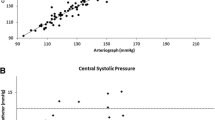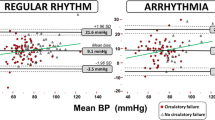Abstract
Objective
Conventional sphygmomanometers are being replaced by automated devices; can they be used to accurately calculate ABPI?
Method
Thirty-six volunteers (72 legs) attending a vascular clinic had their ankle, brachial blood pressure and ABPIs calculated using each of these 3 methods. (1) Conventional aneuroid BP cuff with hand held doppler. (2) OMRON HEM 705CP portable automated BP monitor. (3) The hand held doppler to determine systolic BP measured by the OMRON.
Results
Conventional doppler readings for brachial and ankle pressures were generally higher than those obtained digitally by less than 3 mmHg but this was not statistically significant. This did not translate into a significant difference in ABPIs obtained using all 3 techniques; the correlation coefficient of conventional ABPI with automated ABPI (method 2) was 0.746, this was improved to 0.899 using method 3. The OMRON failed to detect a signal in 16 of the 72 legs, 11 of these legs had ABPIs <0.66.
Conclusion
Conventional doppler measurements give higher readings for systolic blood pressure but there is no significant difference when calculating ABPI. A normal digital ABPI excludes significant vascular disease and a low digital ABPI indicates disease. If no blood pressure is recordable a doppler should be used to confirm the true result. Automated oscillometric BP monitors may be used to accurately measure ABPI in non-diabetics in the community without teaching clinicians to use a doppler, thus removing observer error. This may be of particular use in the community to exclude significant arterial disease in venous ulcer patients and assess general cardiovascular risk.
Similar content being viewed by others
References
O’Brien E, Waeber B, Parati G, Staessen J, Myers MG. Blood pressure measuring devices: recommendations of the European Society of Hypertension. BMJ 2001;322(7285):531–536.
Park MK, Menard SW, Yuan C. Comparison of auscultatory and oscillometric blood pressures. Arch Pediatr Adolesc Med 2001;155(1):50–53.
Amoore JN. A simulation study of the consistency of oscillometric blood pressure measurements with and without artefacts. Blood Press Monit 2000;5(2):69–79.
Carter SA. Clinical measurement of systolic pressures in limbs with arterial occlusive disease. JAMA 1969, 207(10):1869-&.
de Graaff JC, Ubbink DT, Legemate DA, de Haan RJ, Jacobs MJ. Interobserver and intraobserver reproducibility of peripheral blood and oxygen pressure measurements in the assessment of lower extremity arterial disease. J Vasc Surg 2001;33(5):1033–1040.
Jeelani NUO, Braithwaite BD, Tomlin C, MacSweeney ST. Variation of method for measurement of brachial artery pressure significantly affects ankle-brachial pressure index values. Eur J Vasc Endovasc Surg 2000;20(1):25–28.
Kaiser V, Kester AD, Stoffers HE, Kitslaar PJ, Knottnerus JA. The influence of experience on the reproducibility of the ankle brachial systolic pressure ratio in peripheral arterial occlusive disease. Eur J Vasc Endovasc Surg 1999;18(1):25–29.
Ray SA, Srodon PD, Taylor RS, Dormandy JA. Reliability of ankle-brachial pressure index measurement by junior doctors. Br J Surg 1994;81(2):188–190.
Fisher CM, Burnett A, Makeham V, Kidd J, Glasson M, Harris JP. Variation in measurement of ankle-brachial pressure index in routine clinical practice. J Vasc Surg 1996;24(5):871–875.
Fowkes FG, Murray GD, Butcher I, Heald CL, Lee RJ, Chambless LE, et al. Ankle brachial index combined with Framingham Risk Score to predict cardiovascular events and mortality: a meta-analysis. JAMA 2008;300(2):197–208.
White R. A new standard for the nursing assessment of leg ulcers. Br J Nurs 1999;8(19):1272–1279.
Elliot E, Russell B. Setting a standard for leg ulcer assessment. J Wound Care 1996;5(6):173–175.
Mundt KA, Chambless LE, Burnham CB, Heiss G. Measuring ankle systolic blood-pressure—validation of the Dinamap 1846sx. Angiology 1992;43(7):555–566.
Adiseshiah M, Cross FW, Belsham PA. Ankle blood-pressure measured by automatic oscillotonometry—a comparison with Doppler pressure measurements. Ann R Coll Surg Engl 1987;69(6):271–273.
Lee BY, Campbell JS, Berkowitz P. The correlation of ankle oscillometric blood pressures and segmental pulse volumes to Doppler systolic pressures in arterial occlusive disease. J Vasc Surg 1996;23(1):116–122.
Blebea J, Ali MK, Love M, Bodenham R, Bacik B. Automatic postoperative monitoring of infrainguinal bypass procedures. Arch Surg 1997;132(3):286–291.
Ramanathan A, Conaghan PJ, Jenkinson AD, Bishop CR. Comparison of ankle-brachial pressure index measurements using an automated oscillometric device with the standard doppler ultrasound technique. Anz J Surg 2003;73(3):105–108.
Obrien E. Accuracy of the Dinamap 8100. Am J Hypertens 1997;10(1):143–144.
Obrien E, Atkins N. Inaccuracy of the Dinamap 8100 portable monitor. Lancet 1997;349(9057):1026–1026.
Author information
Authors and Affiliations
Corresponding author
Additional information
MacDonald E, Froggatt P, Lawrence G, Blair S. Are automated blood pressure monitors accurate enough to calculate the ankle brachial pressure index?
Rights and permissions
About this article
Cite this article
MacDonald, E., Froggatt, P., Lawrence, G. et al. Are Automated Blood Pressure Monitors Accurate Enough to Calculate the Ankle Brachial Pressure Index?. J Clin Monit Comput 22, 381–384 (2008). https://doi.org/10.1007/s10877-008-9146-8
Received:
Accepted:
Published:
Issue Date:
DOI: https://doi.org/10.1007/s10877-008-9146-8




